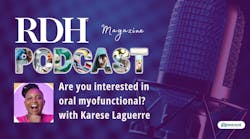Maximizing your investment in oral myofunctional therapy education: Practical applications in clinical dental settings
Listen to the article on our podcast!
Every few years there is a new technique or promising skill that tempts dental clinicians to dive headfirst into continuing education. Unsurprisingly, the concept of using artificial intelligence to conserve chair time while channeling a childhood Jetson’s fantasy is as appealing as restoring patient health without a scaler through oral myofunctional therapy (OMT). Naturally these trends make their way to the stages of conferences and digital platforms and heighten the desire to implement them. However, a challenge arises with implementation, as a one- to three-hour continuing education course is unable to teach the foundational information in addition to comprehensive application. Maximizing the investment in these professional education courses is critical to creating the positive changes that improve career satisfaction and reduce clinical burnout.
Myofunctional therapy stands out for dental hygienists interested in either expanding their professional skills or transferring them to nonclinical opportunities. Yet, as awareness grows and airway education gains more space on stages in conferences, implementation is often the hurdle that is hardest to overcome with this modality. It requires comprehensive awareness of the problems, the ability to assess clinically for case selection, effectively translate the problem to the patient for case acceptance, and then proficiently deliver the therapy for success.
Hygienists are often frustrated after taking nearly 30 hours of introductory courses, many of which contain no practical, hands-on work. Online forums and Facebook groups in OMT are flooded with posts of frustration and complaints of this nature. However, with a strategic approach, it is possible to make the most of that initial investment and begin to implement OMT practically in clinical dentistry.
Oral myofunctional disorders
Understanding how tongue posture can influence palatal growth is akin to previous knowledge that thumb-sucking can alter palatal shape and vault.1 Confidently translating that to the importance of oral soft tissue posture and pressures is the first step. Beyond the introductory course, continual learning is essential to strengthen the foundation of education regarding oral myofunctional disorders (OMDs). Characterized by over- or underutilization of the muscles in the orofacial and oropharyngeal region, OMDs serve as a GPS in the clinical assessment. Signs and symptoms are similar to common parafunctional habits such as mouth-breathing, lip-biting, tongue-sucking, finger-sucking, or many other improper uses of the oral cavity and its structures. Research to refine your understanding of OMDs will enhance your perception of them in clinical practice as you begin to assess and screen patients.
Screening for OMDs
Once you are ready to screen, simplifying the process to fit within your current routine will help to seamlessly integrate these new skills. Simple screeners such as the BROOMS method can identify key signs of OMDs and enable fast analysis that does not take away from clinical time. The BROOMS screener focuses on six easy-to-identify signs: bruxism, respiration, open mouth posture, oral defensiveness, maxillary arch width, and strained mentalis.2
Each element of BROOMS provides valuable insights into oral function and dysfunction. Bruxism helps identify signs of teeth-grinding and its potential connection to sleep apnea. Respiration mode assesses nasal versus mouth-breathing, recognizing mouth-breathing as a potential indicator of dysfunction. Open mouth resting posture sheds light on tongue position and airway health, while oral defensiveness highlights proper or improper resting habits of the tongue and lips. Maxillary width, a measure of the dental arch, gives clues about tongue posture and growth patterns. Finally, the strained mentalis muscle indicates tension that may reflect compensatory oral habits.
Patient education
After screening and data collection, make notes and engage in light conversation with your patients about your findings. Honesty can improve the reception of these findings for patients you may have a long history with.3 Inform them that you are always enhancing your skills and education—a truth they may be unaware of with our continuing education requirements. In recent studies and courses, there are correlations between oral muscular function and oral health. Let patients know that you have done a preliminary screening and are making notes. Lightly review two to three things you found during assessment and encourage patients not to worry since you will screen again at their next visit. Between now and then, offer patients some resources where they can learn more—books, podcasts, social media accounts, or research that will highlight their own awareness of their oral function and enhance conversation at the next dental visit.
Your relationship with therapists
As this process continues, your clinical perception of OMDs and screening will become refined and your speed of assessment will improve. When the next cycle of patient visits occur, be prepared with a triage plan. Taking an introductory OMT course is not always done with the intention of becoming a full-time therapist. Triage sequencing depends on how you intend to implement your knowledge into your career.
When referring to a local therapist, begin by networking as early as possible. All myofunctional therapists are not created equal; many have specialized case niches. Understand their process in the same capacity as you would any other referral source. Speak about your myofunctional therapist with the same clarity and confidence that you’d explain a referral to a periodontist. During an initial meeting with a therapist, inquire about ideal clients to refer, special skills your therapist may possess, the therapeutic process itself, and how to refer patients.
Interim care
Triaging interim care can be a helpful next step when myofunctional therapy services are unavailable in your area or beyond your ability to address. Nasal and sleep hygiene education can be transformative first steps that create positive change. Providing instructions for nasal passage cleansing or irrigation with a saline rinse can aid in promoting nasal patency. Wearing a nasal strip or dilator during sleep can maintain nasal patency, reducing the collapse that’s common with sleep disordered breathing.4
Myofunctional therapy often involves oropharyngeal exercises that can aid in sleep quality by opening the velopharyngeal space. Advising about routine daily exercises is ideal for patients with sleep disordered breathing who are unable to seek personalized treatment through a complete myofunctional therapy program.5 Interim care also builds confidence for both provider and patient that this natural modality is an effective method for the resolution of dysfunctional breathing and sleep.
Importance of collaboration
Collaboration is the backbone of every successful myofunctional therapy outcome. Triaging care can extend beyond the walls of the dental office. It is important to network with local medical, alternative, holistic, and dental providers who can add valuable care and relief for those with OMDs. Manual therapists, sometimes referred to as bodyworkers, perform treatments that can release tension and strain on the soft tissues in the head and neck region that contribute to poor posture, pain, and the inability to refine motor skills in the orofacial region. Chiropractors, osteopaths, craniosacral therapists, physical therapists, and massage therapists are among the professionals classified as manual therapists.
Otolaryngologists, commonly known as ENTs or ear, nose, and throat doctors, are ideal to evaluate physiological barriers that may prevent nasal breathing or block the upper respiratory tract. Sometimes medical intervention is ideal, and when OMDs are identified early, the patient avoids roadblocks that would have prevented progression through a myofunctional therapy program.
An orthodontist is also an ideal referral partner for those with narrow maxillary transverse width. If the palate is narrow and vaulted, it is impossible to train the tongue to rest in the space. Akin to parking a pickup truck in a compact garage and creating damage to the truck and structure, more space would be suitable for long-term results to be achieved in tongue posture. Referring out for palatal expansion aids in creating a comfortable home for the tongue to rest.
Beyond triaging, remain open-minded. New information develops often in the field of OMT, and it will become important to continue learning as you build comfort and confidence. Continuing education occurs formally in classrooms, virtually and on-site; however, the triaging process can be similarly educational. Joining a professional association, local study club, or social media community will provide additional continuing education in OMDs. Fine-tuning the quick identification of signs and symptoms can help fine-tune your communication with patients and providers.
Remain patient with yourself throughout this process. Just as you gained more skills and education in clinical dental hygiene, slow and steady implementation of myofunctional therapy will enable you to maximize your investment. Embrace the journey, knowing that each step brings you closer to a deeper understanding and more profound impact in your practice. With dedication, continuous learning, and collaboration, you can transform your initial investment into a rewarding and fulfilling career path that benefits both you and your patients.
Editor's note: This article appeared in the November/December 2024 print edition of RDH magazine. Dental hygienists in North America are eligible for a complimentary print subscription. Sign up here.
References
- Goodreau A. The Relationship of Tongue Position via the Modified Mallampati Tongue Score to Craniofacial Morphology and Head Posture. Thesis/Dissertation. Temple University; 2022. doi:10.34944/dspace/8039
- Laguerre K. BROOMS: systematic screening for oral myofunctional disorders. RDH. September 28, 2023. https://www.rdhmag.com/pathology/airway-disorders/article/14299439/brooms-systematic-screening-for-oral-myofunctional-disorders
- Tiwari T, Maliq NN, Rai N, et al. Evaluating trust in the patient–dentist relationship: a mixed-method study. JDR Clin Trans Res. 2022;8(3):287-298. doi:10.1177/23800844221087592
- Crambert A, Morvan JB, Guyen-Bomba A, de Regloix S. Improvement in nasal obstruction and quality of life after nasal saline irrigation in 62 military projected in desert area. Int Rev Armed Forces Medical Services. 2023;96(3):11-15.
- Atilgan E, Kunter E, Algun ZC. Are oropharyngeal exercises effective in obstructive sleep apnea syndrome? J Back Musculoskelet Rehabil. 2020;33(2):209-216. doi:10.3233/BMR-171101








